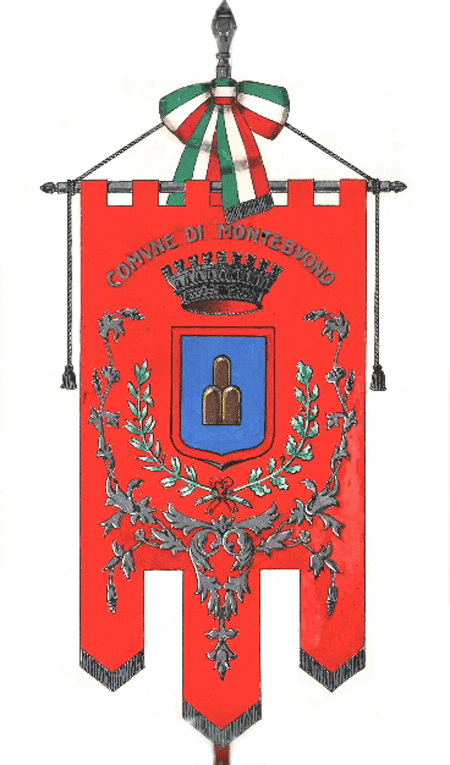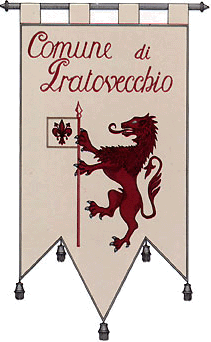
Gonfalone
Encyclopedia



Italian language
Italian is a Romance language spoken mainly in Europe: Italy, Switzerland, San Marino, Vatican City, by minorities in Malta, Monaco, Croatia, Slovenia, France, Libya, Eritrea, and Somalia, and by immigrant communities in the Americas and Australia...
confalone), is a type of heraldic flag
Heraldic flag
In heraldry and vexillology, an heraldic flag is any of several types of flags, containing coats of arms, heraldic badges, or other devices, used for personal identification....
or banner
Banner
A banner is a flag or other piece of cloth bearing a symbol, logo, slogan or other message. Banner-making is an ancient craft.The word derives from late Latin bandum, a cloth out of which a flag is made...
, often pointed, swallow-tailed, or with several streamers, and suspended from a crossbar. It was first adopted by Italian medieval commune
Medieval commune
Medieval communes in the European Middle Ages had sworn allegiances of mutual defense among the citizens of a town or city. They took many forms, and varied widely in organization and makeup. Communes are first recorded in the late 11th and early 12th centuries, thereafter becoming a widespread...
s, and later, by local Guilds, Corporations and Districts.
A gonfalon can include a badge or coat of arms, or ornamentations of fancy design. Today every Italian comune
Comune
In Italy, the comune is the basic administrative division, and may be properly approximated in casual speech by the English word township or municipality.-Importance and function:...
(municipality) has a gonfalon sporting its coat of arms
Coat of arms
A coat of arms is a unique heraldic design on a shield or escutcheon or on a surcoat or tabard used to cover and protect armour and to identify the wearer. Thus the term is often stated as "coat-armour", because it was anciently displayed on the front of a coat of cloth...
.
The gonfalon has long been used for ecclesiastical ceremonies and processions. The papal "ombrellino", a symbol of the pope, is often mistakenly called "gonfalone" by the Italians because the pope's ceremonial umbrella was often depicted on the banner.
Gonfalone was originally the name given to a neighbourhood meeting in medieval Florence, each neighbourhood having its own flag and coat of arms, leading to the word Gonfalone eventually becoming associated with the flag.
Gonfalons are also used in some university ceremonies, such as those at the University of Chicago
University of Chicago
The University of Chicago is a private research university in Chicago, Illinois, USA. It was founded by the American Baptist Education Society with a donation from oil magnate and philanthropist John D. Rockefeller and incorporated in 1890...
, Rutgers University
Rutgers University
Rutgers, The State University of New Jersey , is the largest institution for higher education in New Jersey, United States. It was originally chartered as Queen's College in 1766. It is the eighth-oldest college in the United States and one of the nine Colonial colleges founded before the American...
, Princeton and The University of St. Thomas, MN.
Religious significance
Gonfalons had great significance as Christian religious objects in Europe during the Medieval period, especially in central ItalyItaly
Italy , officially the Italian Republic languages]] under the European Charter for Regional or Minority Languages. In each of these, Italy's official name is as follows:;;;;;;;;), is a unitary parliamentary republic in South-Central Europe. To the north it borders France, Switzerland, Austria and...
. These religious objects consisted of a cloth, usually of canvas but occasionally of silk, supported by a wooden frame with a T-shaped support on the back, and a long pole to hold up the banner during ceremonies and processions. The banners were painted with tempera
Tempera
Tempera, also known as egg tempera, is a permanent fast-drying painting medium consisting of colored pigment mixed with a water-soluble binder medium . Tempera also refers to the paintings done in this medium. Tempera paintings are very long lasting, and examples from the 1st centuries AD still exist...
or oil
Oil
An oil is any substance that is liquid at ambient temperatures and does not mix with water but may mix with other oils and organic solvents. This general definition includes vegetable oils, volatile essential oils, petrochemical oils, and synthetic oils....
paints, sometimes on both sides. Images on the gonfalons included the patron saints of cities, villages, confraternities
Confraternity
A confraternity is normally a Roman Catholic or Orthodox organization of lay people created for the purpose of promoting special works of Christian charity or piety, and approved by the Church hierarchy...
or guilds, the Virgin and Child, Jesus Christ, God the Father
God the Father
God the Father is a gendered title given to God in many monotheistic religions, particularly patriarchal, Abrahamic ones. In Judaism, God is called Father because he is the creator, life-giver, law-giver, and protector...
, plague saint
Saint
A saint is a holy person. In various religions, saints are people who are believed to have exceptional holiness.In Christian usage, "saint" refers to any believer who is "in Christ", and in whom Christ dwells, whether in heaven or in earth...
s, and the Virgin Mary as Queen of Heaven
Queen of Heaven
Queen of Heaven is a title given to the Blessed Virgin Mary by Christians, mainly of the Roman Catholic Church, and also, to some extent, in the Anglican, Lutheran, and Eastern Orthodox churches, to whom the title is a consequence of the Council of Ephesus in the fifth century, where the Virgin...
, Mediatrix, Theotokos
Theotokos
Theotokos is the Greek title of Mary, the mother of Jesus used especially in the Eastern Orthodox, Oriental Orthodox, and Eastern Catholic Churches. Its literal English translations include God-bearer and the one who gives birth to God. Less literal translations include Mother of God...
, or Madonna of Mercy. Because these banners were often associated with a particular group, highly unusual and individual iconography
Iconography
Iconography is the branch of art history which studies the identification, description, and the interpretation of the content of images. The word iconography literally means "image writing", and comes from the Greek "image" and "to write". A secondary meaning is the painting of icons in the...
could appear.
These gonfalons were often commissioned and kept by confraternities, lay religious groups who gathered together for devotional purposes such as the singing of hymns (laudae), the performance of charitable works, or flagellation
Flagellation
Flagellation or flogging is the act of methodically beating or whipping the human body. Specialised implements for it include rods, switches, the cat o' nine tails and the sjambok...
. The banners would be either displayed on the wall of the oratory
Oratory (worship)
An oratory is a Christian room for prayer, from the Latin orare, to pray.-Catholic church:In the Roman Catholic Church, an oratory is a structure other than a parish church, set aside by ecclesiastical authority for prayer and the celebration of Mass...
or packed away until they were needed for their primary use, religious processions. During processions, the banner would be carried on its pole by members of the confraternity. This devotional act of carrying the banner in procession was believed to be a holy act of worship, and it was hoped that the act would gain divine favour from God, Jesus, Mary, and the saints portrayed on the banner. From the thirteenth to the sixteenth centuries, plague banners were produced and carried in processions as a way to plead for divine intercession to prevent or cure the plague.
See also
- KhorugvKhorugvKhorúgv , is a religious banner used liturgically in the Eastern Catholic and Eastern Orthodox Churches.The khorugv or banner consists of an icon of Christ, the Theotokos or a saint, either painted or embroidered on a rectangular piece of cloth. The cloth will often be pointed, swallow-tailed, or...
, a gonfalone analogue in Christian churches of East-European origin - Baseball's Sad Lexicon, 1910 poem referring to a baseball championship pennant as a "gonfalon"
- GonfaloniereGonfaloniereThe Gonfaloniere was a highly prestigious communal post in medieval and Renaissance Italy, notably in Florence and the Papal States. The name derives from gonfalone, the term used for the banners of such communes....
- Coat of armsCoat of armsA coat of arms is a unique heraldic design on a shield or escutcheon or on a surcoat or tabard used to cover and protect armour and to identify the wearer. Thus the term is often stated as "coat-armour", because it was anciently displayed on the front of a coat of cloth...
- Flagellant Confraternities (Central Italy)Flagellant Confraternities (Central Italy)Central Italian flagellant confraternities evolved and emerged from Central Italian confraternities that originated in the tenth century. The members of these original confraternities were lay persons who were devoted to religious life.These groups promoted religious life but were independent of...

